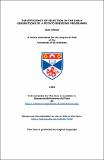Files in this item
The efficiency of selection in the early generations of a potato breeding programme
Item metadata
| dc.contributor.advisor | Abbott, Richard J. | |
| dc.contributor.advisor | Caligari, P. D. S. | |
| dc.contributor.author | Brown, Jack | |
| dc.coverage.spatial | 258 p. | en_US |
| dc.date.accessioned | 2015-08-03T15:12:39Z | |
| dc.date.available | 2015-08-03T15:12:39Z | |
| dc.date.issued | 1988 | |
| dc.identifier | uk.bl.ethos.234069 | |
| dc.identifier.uri | https://hdl.handle.net/10023/7107 | |
| dc.description.abstract | The efficiency of selection in the early generations of a potato breeding programme is examined. A number of unselected potato (Solanum tuberosum L) clones were grown in a glasshouse, from true botanical seed, and thereafter in the field at two locations (a seed site and a ware site) for three consecutive years. At each stage, a number of tuber characteristics were visually assessed and yield plus the yield components were recorded. Four potato breeders visually assessed the produce from each clone after harvesting each years trials and were in good agreement as to which clones would be selected in each environment. Selection for visually assessed characters in both the glasshouse and first clonal year produced a desirable response. However, such selection carried a high cost in terms of losing clones with commercial potential. Selecting clones for yield in the seedling and first clonal year was only marginally more effective than a random reduction in number of genotypes, while selection in the second clonal year appeared to be somewhat more effective as judged by performance in later generations. Comparison of a random sample of clones with ones from the same crosses which had been selected at the seedling and first clonal year stage was at best random, with some suggestion, however, of a negative effect. The causes behind the inefficiency of selection were found to be complex. The inefficiency was ascribed, at least in part, to (i) the inaccuracy of assessment on single plant plots; (ii) the "carry-over" effect of the mother tubers and (iii) selection under a short growing season. Although there was a formally significant interaction between progenies and environments, the rank of the mean of a cross remained relatively consistent over different growing conditions. It was found that the mean and square root of the variance obtained from breeders' preference in any of the environments provided a good basis for prediction of the number of clones in each cross which would exceed (or equal) a given target value. The square root of the variance added increasingly to the accuracy of the prediction as the target value increased but was never a major component in such predictions. When the predictions were used to provide ranking of the crosses, the rank correlations showed good agreement between the different environments and between observed and expected ranks. There was no evidence to suggest that univariate cross prediction for any of the other characters under study would not be effective. A new cultivar is unlikely to be successful simply because of high expression for a single character, but will rather be an all round improvement over cultivars already available. Three methods of multivariate cross prediction were therefore examined namely multivariate probabilities, sum of ranks and the frequency of genotypes in a sample that transgress set target values. The characters total tuber weigh t, mean tuber weight, number of tubers and regularity of tuber shape were examined. It was found that a sample as small as 25 clones provided good predictions (as judged by the observed frequencies in a larger progeny sample examined in various environments). The best estimates were obtained using multivariate probabilities based on the means, within progeny variances,. and the phenotypic correlations between variates. The ranking of crosses according to these multivariate probabilities provided good indications of the number of clones which survived selection in an actual breeding scheme. Thus it is suggested that an empirical examination of a sub-sample of the progeny from a cross could be used to determine the crosses which would have the highest probability of producing improved, potato cultivars. Selection of crosses rather than individual clones has several advantages which would favour such techniques being used in the early generations of a potato breeding programme. Cross prediction based on parental performance also provided an indication of the crosses, .and parents, .which would give the highest frequency of desirable recombinants. These predictions were not as accurate as those derived from examination of a sub-sample of progeny from each cross. But they would allow an earlier, and hence powerful, method of prediction. | en_US |
| dc.language.iso | en | en_US |
| dc.publisher | University of St Andrews | |
| dc.subject | Plant breeding | en_US |
| dc.subject.lcc | QH406.P8B8 | |
| dc.title | The efficiency of selection in the early generations of a potato breeding programme | en_US |
| dc.type | Thesis | en_US |
| dc.contributor.sponsor | Scottish Crop Research Institute | en_US |
| dc.type.qualificationlevel | Doctoral | en_US |
| dc.type.qualificationname | PhD Doctor of Philosophy | en_US |
| dc.publisher.institution | The University of St Andrews | en_US |
This item appears in the following Collection(s)
Items in the St Andrews Research Repository are protected by copyright, with all rights reserved, unless otherwise indicated.

